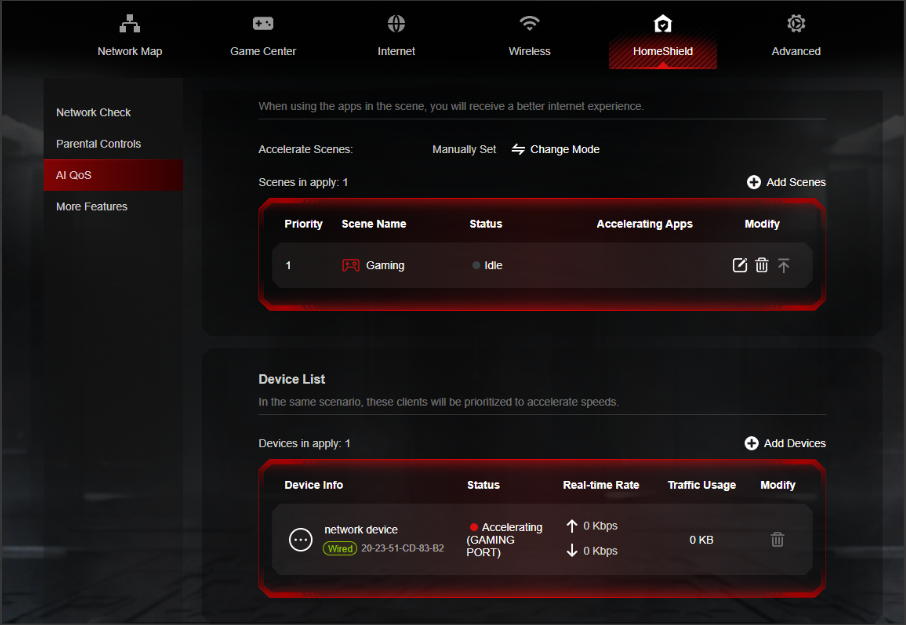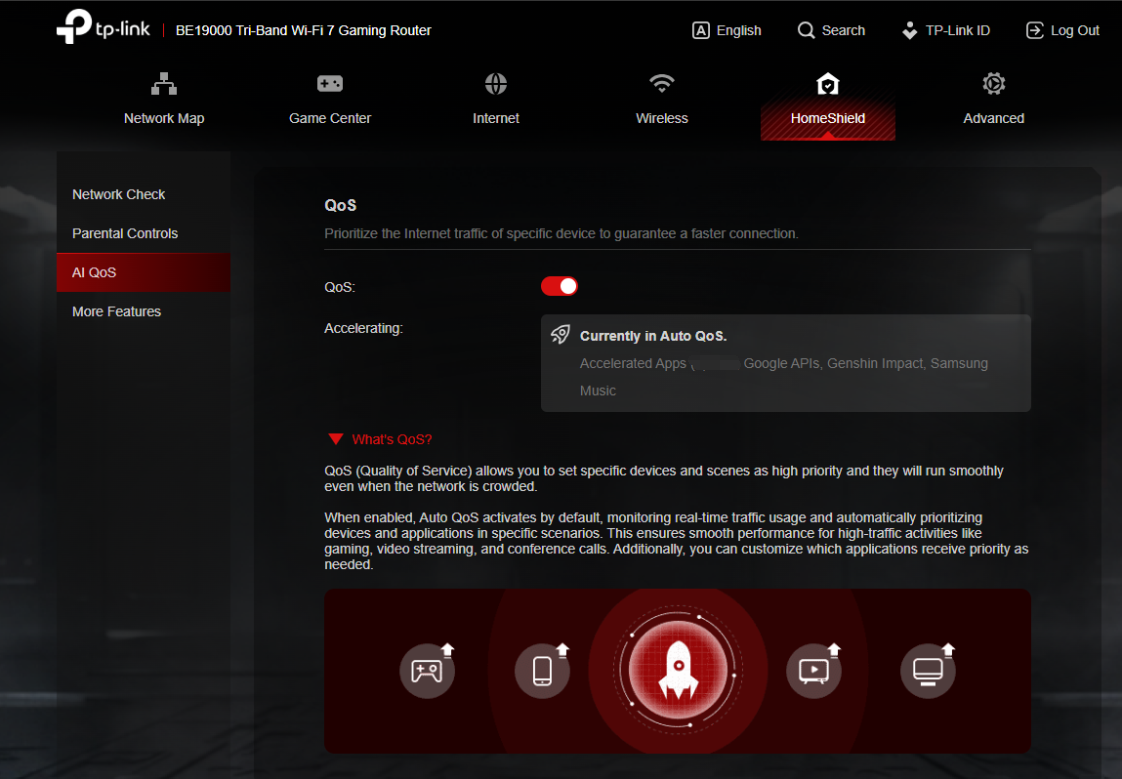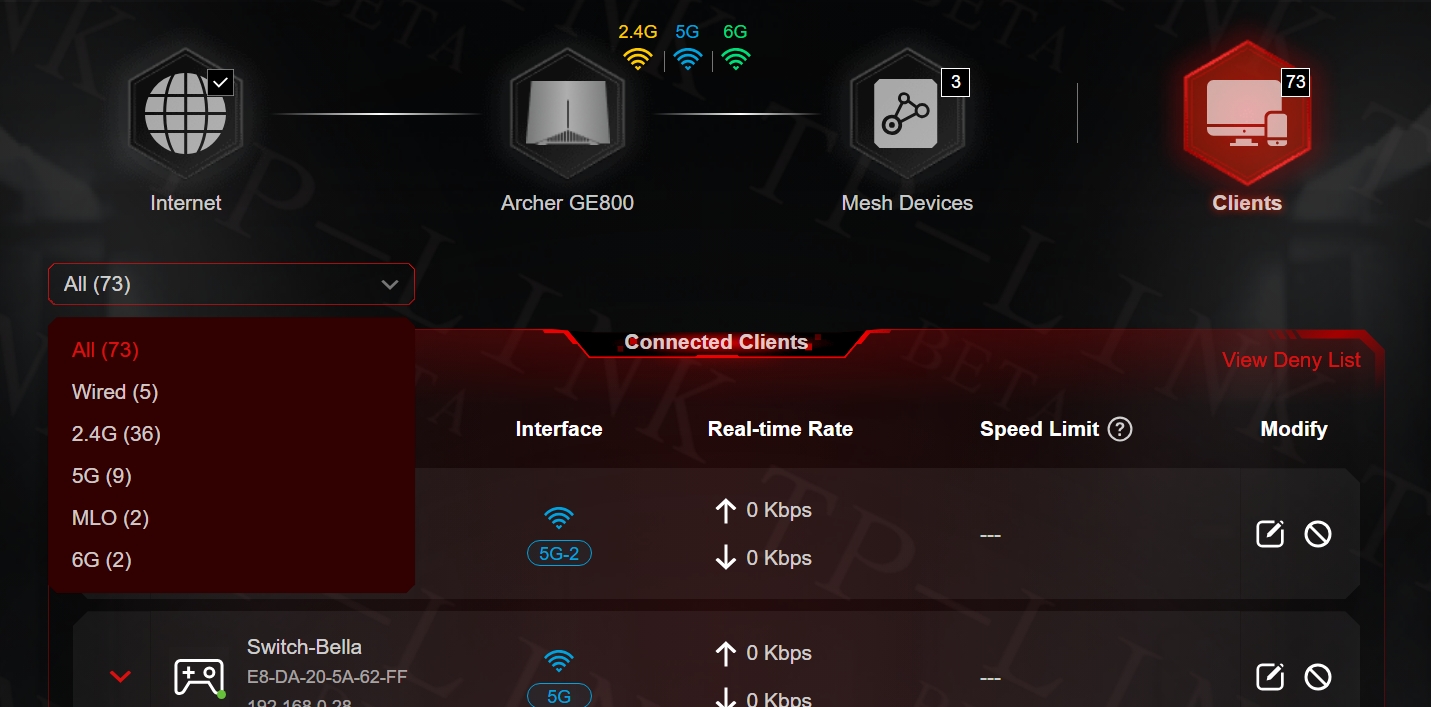Early Access Introducing AI QoS: Elevate Your Gaming Experience on the Archer GE800 Gaming Router!
Hello Everyone,
We are excited to announce a pre-release firmware update introducing AI QoS (Quality of Service) for the Archer GE800 V1 before its official release. This allows our users to enjoy the ultimate gaming experience in advance.
AI QoS is designed to revolutionize your online gaming experience. Leveraging artificial intelligence, our new feature set transforms how your router manages bandwidth, ensuring seamless performance for all your applications. Here are the key features that make AI QoS a game-changer.
One-Click Acceleration
Say goodbye to complicated setups! With just a single click, you can enjoy lightning-fast performance without the hassle of complex configurations. Get ready to dive into your favorite games instantly.

Dynamic Bandwidth Detection
Our advanced technology allows you to instantly assess your available bandwidth. By continuously monitoring network conditions, AI QoS helps prevent congestion, ensuring that your gaming and streaming sessions remain smooth and uninterrupted.
Enhanced QoS Optimization
Experience significantly reduced gaming latency, even in congested network scenarios. AI QoS intelligently optimizes your connection, minimizing lag and providing a competitive edge when it matters most.

Intelligent Traffic Prioritization
Every application deserves the best performance. With AI QoS, traffic is prioritized intelligently, guaranteeing that all your applications run optimally. Whether you're gaming, streaming, or video conferencing, you can be confident that your experience will be top-notch.

More New Features and Modifications:
This pre-release firmware includes all the new features and modifications mentioned in previous posts below:
Pre-release Firmware for Archer GE800/GE550/GE650v1 Supports EasyMesh in AP Mode, DoH&DoT, ECO Mode
Bug Fixes:
Fixed the issue where enabling Bandwidth Control for the Guest Network will take effect for all networks.
Firmware Download:
Before the Upgrade
(1) Please be sure you have read the Beta Test Agreement before upgrading the pre-release firmware!
(2) For the sake of insurance, it's always recommended to save a copy of the router's Backup Config file before upgrading or downgrading.
(3) This pre-release firmware for Archer GE800 V1 can be applied to all versions (EU/US/AU/CA/etc).
(4) You may follow the guide to upgrade the firmware of your router. How to Upgrade the Firmware on the TP-Link Wi-Fi Routers.
(5) The screenshots in this article are taken from the web GUI of Archer GE800 V1 for reference only.
(6) This version of software can be degraded to the previous official version.
Direct Firmware Download Link
| Archer GE800_V1 | Archer GE800(EU)_V1_1.3.2 Build 20251013 (Updated Pre-release firmware) |
Additional Information
As always, we value your feedback. If somehow you encounter an issue during or after the router firmware upgrade, please comment below with the following info. Your input helps us continue to improve and provide the best products and support.
- Provide a detailed network layout, including how the devices are connected, especially if there are EasyMesh satellite devices.
- Detailed issue description, and provide more information on the specific conditions that seem to trigger the problem.
Thank you for your continued support and for being part of our community.
Update Log
Oct 13th, 2025:
Updated to provide a new pre-release firmware based on the latest 1.3.1 official version.
Jul 4th, 2025:
Updated to provide a new pre-release firmware based on the latest 1.2.1 official version.
Jun 13th, 2025:
Release of the article.
Related Articles
Pre-release Firmware for Archer GE800/GE550/GE650v1 Supports EasyMesh in AP Mode, DoH&DoT, ECO Mode
- Copy Link
- Subscribe
- Bookmark
- Report Inappropriate Content
Kevin_Z wrote
raven-au wrote
@Kevin_Z I find it frustrating that 15% to 30% of client devices are missing from the client list.
This happens on 1.1,6 as well as 1.1.8 and is reflected in the web console and the iOS app.
@raven-au Thanks for your feedback.
Does that mean those client devices are not showing up in the main GE800's client list when they are connecting to the satellite BE900?
How are the two BE900s connected to the GE800? Is it like below?
GE800 --- BE900 --- BE900? (--- stands for Ethernet cables/connections)
@Kevin_Z The EasyMesh devices are connected via wireless so it's a tree like structure.
I'll make a few checks to but I believe that the devices are missing from the lists on both main and nodes.
I'll check to see if I can discover any correlation between connected via node and missing but I think they just don't appear in the client list.
I know for sure that I do see some devices that are connected via the nodes so it's not a clear reason for the problem.
- Copy Link
- Report Inappropriate Content
Kevin_Z wrote
raven-au wrote
Also, using the web console the number of clients in each grouping doesn't add up to the number in the All group when using EasyMesh nodes with different wireless radios compared to the main router.
For example, using my GE800 with two BE900 nodes there is no 5GHz-2 grouping in the web console list even though they are present in the All grouing list.
Could you please provide a screenshot to show me the exact issue? I want to ensure I understand it correctly. Does it mean there are 20 devices (for example) connected to the 5GHz-2, but they are not showing up in the 5GHz-2 network list?
@Kevin_Z Here is a screenshot.
If you add up the counts in each of the drop down catagories they do not add up to the total in the All category.
Basically there is a category 5GHz-2 missing but you can see in the screen shot of the "All" category the first entry is a 5GHz-2 entry.

- Copy Link
- Report Inappropriate Content
@raven-au What I can say about the devices that are missing is that sometimes they are actually devices that have are offline but often they are devices that are connected and online because Alexa sees them as online and I can send commands to them like turning off tp-link smart lights for example. So it's at least partly a client list probem.
Btw, in the image above it says it sees 73 devices and I expect that the number of devices in the client list will slowly grow tp the aprrox. 100 devices I have but the GE800 constantly goes up and down between a little more than 60 and a little more than 80 devices and never gets close the 100 or so I have.
- Copy Link
- Report Inappropriate Content
Hello @Kevin_Z,
I apologize let me reiterate. The MLO network is stable per se and not dropping. What happens is I appear to be moving between band 2.4ghz and 5ghz (too far for 6ghz) instead of being connected to both.
The wireless card model is: BE9300 (Latest Driver and Windows 11 24h2)
My phone is Wifi 7: One Plus 13 (worked on previous router firmware)
My laptop supports Wifi 7: has a Intel BE200 (Latest drivers and Windows 11 24h2)
- Copy Link
- Report Inappropriate Content
Innocentone wrote
Hello @Kevin_Z,
I apologize let me reiterate. The MLO network is stable per se and not dropping. What happens is I appear to be moving between band 2.4ghz and 5ghz (too far for 6ghz) instead of being connected to both.
The wireless card model is: BE9300 (Latest Driver and Windows 11 24h2)
My phone is Wifi 7: One Plus 13 (worked on previous router firmware)
My laptop supports Wifi 7: has a Intel BE200 (Latest drivers and Windows 11 24h2)
@Innocentone Thank you very much for your feedback once again.
I've forwarded your feedback to our development team and hope they can confirm it soon.
I will update you here to let you know once this concern is addressed.
BTW, how about the AI QoS? Can you please check how it works in your network?
- Copy Link
- Report Inappropriate Content
raven-au wrote @Kevin_Z Here is a screenshot.
If you add up the counts in each of the drop down catagories they do not add up to the total in the All category.
Basically there is a category 5GHz-2 missing but you can see in the screen shot of the "All" category the first entry is a 5GHz-2 entry.
In the above screenshot, there are 3 mesh devices in the network. What is the model of the third node?
Please clarify what types of devices are most missing from the Client List. Smart IoT devices? What kind of brands and models?
- Copy Link
- Report Inappropriate Content
Kevin_Z wrote
raven-au wrote @Kevin_Z Here is a screenshot.
If you add up the counts in each of the drop down catagories they do not add up to the total in the All category.
Basically there is a category 5GHz-2 missing but you can see in the screen shot of the "All" category the first entry is a 5GHz-2 entry.
In the above screenshot, there are 3 mesh devices in the network. What is the model of the third node?
Please clarify what types of devices are most missing from the Client List. Smart IoT devices? What kind of brands and models?
I thought I already mentioned that, the network is a GE800 and two BE900's.
As far as missing device types go it's hard to say.
Lately I've been noticing Tapo P110M's, Tapo L535's and to a lesser extent Tapo P300 most but that might be because I have more of those than anything else.
But also I don't see all my Sony TV's (2 to 4 of 7) or all my Rinnai Air conditioners (usually 3 of 5).
I'm pretty sure I don't see this with my BE95 Deco's.
I would need to spend a lot more time to profile what I'm not seeing ...
- Copy Link
- Report Inappropriate Content
Sorry, my bad.
I thought there would be 3 EasyMesh satellite nodes when it displays 3 in the Mesh Devices. I might be misunderstanding this display.![]()
From what I understand, I assume that these smart IoT devices disappear randomly from the network client list because they are not responding to an ARP request broadcast. This may require further investigation using Wireshark.
If you would like to investigate this further, I would be more than happy to escalate your case to our support engineers. They will try to work it out and provide a solution.
- Copy Link
- Report Inappropriate Content
Kevin_Z wrote
Sorry, my bad.
I thought there would be 3 EasyMesh satellite nodes when it displays 3 in the Mesh Devices. I might be misunderstanding this display.
From what I understand, I assume that these smart IoT devices disappear randomly from the network client list because they are not responding to an ARP request broadcast. This may require further investigation using Wireshark.
If you would like to investigate this further, I would be more than happy to escalate your case to our support engineers. They will try to work it out and provide a solution.
@Kevin_Z Yes, the EasyMesh main router is included in that count, ;)
I know I've implied the missing devices are IoT devices but they are not alone, the TV's for example aren't IoT devices, so it's not just IoT devices.
I'm not sure this is an ARP problem either, as I have said earlier, Alexa control seems to work Ok and is quite responsive.
On the other hand the ASUS WiFi 7 routers I have I see ping timeouts mostly only (maybe completely) for IoT devices which would also make ARP resolution unreliable and when using Alexa I see it fail to carry out tasks or quite slow response or simply no action taken at all.
I can't say support engineering (I assume that's who gets the request when one is logged) has been very useful in the past so I haven't bothered to log further problems with them. But in this case I will do any requested investigation tasks and see how it goes.
Keep in mind that I do need to work (from home) so I may not be able to do what's needed straight away.
- Copy Link
- Report Inappropriate Content
Hey @ZeldaFX @Elroy1 @Pro-gamer @raven-au @Innocentone,
Just want to ask: have you tried enabling the AI QoS feature on the GE800 to monitor how it would improve your network's performance?
We would appreciate your feedback.
- Copy Link
- Report Inappropriate Content
Information
Helpful: 7
Views: 52548
Replies: 410
